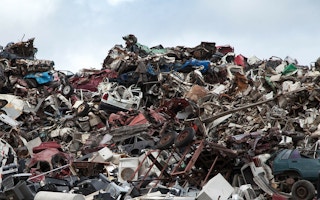The world economy is only 9 per cent circular, and more than 90 per cent of the raw materials used to do business and sustain the global population go to waste instead of being cycled back into the economy, a new report by Dutch social enterprise Circle Economy has found.
To continue reading, subscribe to Eco‑Business.
There's something for everyone. We offer a range of subscription plans.
- Access our stories and receive our Insights Weekly newsletter with the free EB Member plan.
- Unlock unlimited access to our content and archive with EB Circle.
- Publish your content with EB Premium.
Released on Tuesday in Davos, Switzerland on the sidelines of the World Economic Forum meeting, the Circularity Gap Report launched this new metric to quantify the degree to which the global economy is circular. A circular economy is one where materials and nutrients are recycled and reused instead of being wasted after a single use; this latter linear model is often described as “take, make, waste”.
Circle Economy’s statistic was derived by comparing the amount of resources entering the global economy annually with the volume of materials being “cycled back” into the economy through measures such as recycling, composting, and conversion into fuels such as biogas. The data was derived from resource database Exiobase.
Overall, about 92.8 billion tonnes of resources are pumped into the economy every year, but only 8.4 billion tonnes are recycled. The most resource-intensive sector is housing and infrastructure with a footprint of 42.4 billion tonnes, followed by agriculture and transport.
Harald Friedl, chief executive officer, Circle Economy, told Eco-Business that the fact that the world is only 9 per cent circular was not a surprise, and was within the researchers’ expected range of results.
“The goal of the report was to create a strong metric that is needed to rally support, create awareness, and make impact measurement possible,” he added.
Marc de Wit, director of strategic alliances, Circle Economy, said that “the real value of a global circularity metric lies in being able to track changes over time and measure progress, put main trends into context, engage in uniform goal-setting and guide future action in the most impactful way”.
“In order to understand how to move to a circular state globally we need to understand what is not circular about our economy today,” added de Wit, who is also the report’s lead author.
Climate connection
Making the global economy more circular—or ‘closing the circularity gap’ as the report calls it—would not only lead to more efficient resource use, but also help address climate change and help achieve the United Nations’ Sustainable Development Goals (SDGs), the report said.
The SDGs are a set of 17 targets adopted by the global community in 2015, including ending hunger and poverty, fighting climate change, and promoting more responsible patterns of production and consumption.
The circular economy has the potential to address climate change because 67 per cent of global greenhouse gas emissions are related to material management, said the report—that is, extracting resources, refining them, moving them around, and processing them at the end of use.
Minimising the extraction and waste of resources, and extending the lifeline of those already in circulation can have a significant impact on the climate, say experts. For instance, the Ellen MacArthur Foundation, a UK-based circular economy think-tank, estimates that shifting to a circular economy could slash India’s greenhouse gas emissions by 40 per cent compared to business as usual models.
Four-step plan
Best practices in a circular economy include legislation that requires manufacturers to take responsibility for their products across their lifespan, business models that unlock value from waste—a famous example is American carpet maker Interface turning discarded fishing nets into carpet —and diverting products from landfill by reusing, recycling, or repairing them instead.
But as the report showed, the world has a long way to go to make these practices the default business model. To accelerate this shift, Circle Economy identified four strategies that can help close the circularity gap.
First, it suggested that businesses, governments, non-government organisations and academics should form a global coalition for action, and produce an annual report that documents how the world is progressing towards a circular economy.
Second, there should be a global target for a circular economy and an action agenda on how to achieve it. A comparable target is the global goal of capping temperature rise at 2 degrees Celsius above 1990 levels to avoid dangerous climate change, Friedl noted.
Third, countries, sectors, businesses, and cities should work to translate these global targets into local strategies, so that they are appropriate for their specific context.
And finally, the global community should improve its understanding of how solutions for the circular economy affect interconnected outcomes such as economic value, climate mitigation, international trade, and employment.
There will be challenges to implementing these measures, especially in Asia, which has recently been identified as the source of much of the world’s plastic pollution, Friedl noted. They include a legal framework today that supports linear economic models more than circular ones; human behaviour that fuels the linear “take-make-waste” economic system; and a lack of strong and visionary leadership.
Ultimately, everyone needs to get on board with circular economy efforts or risk incurring a heavy environmental and social cost, he urged.
“Today’s Take-Make-Waste economic model is not fit for purpose. Embedded in this tradition of the linear economy lies a toxic cocktail of negative consequences, ranging from social inequality, to depletion of natural resources, environmental pollution and worsening of the risks and effects of climate change,” he said.
He added: “We call upon businesses and governments to take leadership to develop an action agenda and contribute to the global targets set in the SDGs and the Paris Agreement.”










